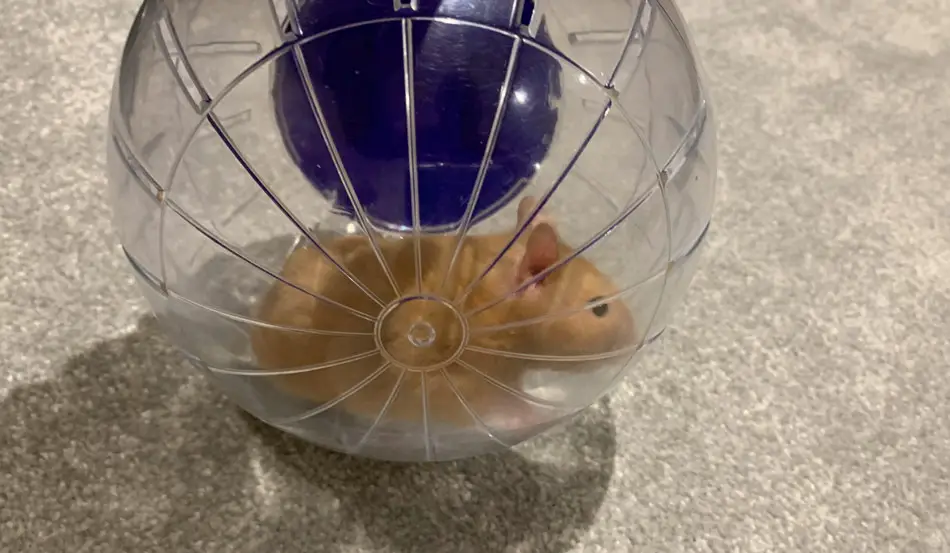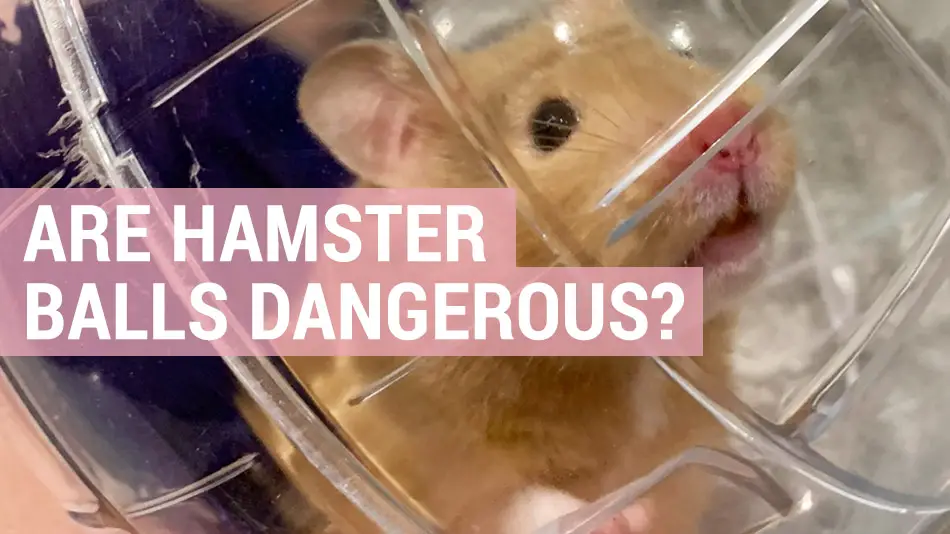Following a recent experience where our pet hamster Oscar refused to come back when let loose in our sitting room, we decided to look at alternative ways to exercise him. And, having visited the pet shops and researched online, the most common way to exercise a hamster appeared to be a free spinning hamster exercise ball. Hamster exercise balls have, over the years, been controversial, so are they actually safe to use and do hamsters really enjoy being in them?
A hamster exercise ball, when used correctly, can be entertaining giving your hamster free reign to explore in a safe and secure environment. If, however, a hamster exercise ball is used incorrectly, there is a chance that it can cause more harm than fun.
Hamsters, although nocturnal are incredibly active animals, who enjoy spending time being handled out of their cage. But it is not always safe (as we discovered), to let your hamster explore to their hearts content. Therefore other options such as hamster exercise balls offer a wonderful way to let your small pet burn off energy and have fun.
What is a hamster exercise ball?
A hamster exercise ball is made of tough, see-through plastic and often comes in two half spheres which join or screw together. Each ball has a number air hole slits to enable the hamster to breathe as they rotate and a twist top to allow you to place your hamster in securely.
Some hamster exercise balls come with stands, which gives you the option to keep your hamster in one place or allow them the freedom to explore.
How to choose a hamster exercise ball
Just like a hamster wheel, one size does not fit all. Your hamster needs plenty of space in which to run so you need to ensure that their spine is not bent in the process.
For a Syrian hamster we would recommend using an exercise ball that is at least 8”, although bigger is preferable. If the ball is too small, then they may struggle to not only run but breathe.
Large balls may be too heavy for a dwarf hamster to maneuver, and if the ventilation holes are too big, then your hamsters’ feet could get caught. For a dwarf hamster, a 7” hamster exercise ball should suffice, but always make sure you seek professional advice if you are unsure.
It is also recommended that you choose a light-colored ball – we chose a translucent one – as the darker colored hamster exercise balls tend to hold heat. Plus, with a clear ball you can easily see your hamster running inside and they can see out.
Although Russian hamsters enjoy the company of others, it is important that you only ever place one hamster at a time inside each exercise ball. Placing two together in such a confined space, could lead to them injuring one another through a collision or potentially end in a fight.

How to use a hamster exercise ball
The temptation when you first purchase an exercise ball, is to place your hamster in it straight away and watch them set off. Just like any new environment, however, it is important for your hamster to get used to it on their accord. Initially your hamster may be wary of the exercise ball, especially as it is an enclosed space.
Therefore, just like taming a hamster, you should take the time to introduce them to their exercise ball and wait until they are happy to walk inside themselves. We found with Oscar, that by placing it inside his cage over a number of nights for him to smell and explore on his own terms, definitely helped him feel at ease.
You should also never force your hamster to go inside. If they are still sleepy or unsure then you should assume that they are not in the mood for exercise. If, however, they are happy, wide awake, and eager to step inside then you are good to go. Just remember, like humans, hamsters should never exercise after eating in order to give their bodies the chance to digest.
Once safely inside and secure, you should place the hamster exercise ball on the floor. Never roll the ball yourself, instead, let your hamster pick their preferred pace.
Make sure that you clean your hamster ball thoroughly after use, in case there are any droppings.
How can you tell if you hamster enjoys the ball?
Refusing to walk into the ball is the biggest sign that your hamster is not ready (and may never be ready) to use the exercise ball. Digging, biting and trying to get out are other signs that your hamster is not happy to be in the exercise ball.
It is really important that your hamster feels comfortable whilst running around and is not in any way distressed.

How long can a hamster be in an exercise ball?
As long as there is plenty of air circulating through the hamster exercise ball and they are not exposed to direct sunlight, then your hamster should be able to roll around for 15-20 minutes.
Any longer than this and they may start to suffer from fatigue or dehydration. You can often tell when your hamster has had enough of their exercise ball, as they start to slow down, stop completely or spend a long time grooming themselves.
It is important to monitor your hamster at all times whilst it is in the exercise ball to ensure that they are free from dangers such as:
- Stairs – block off access to stairways and make sure that your hamster is well away from any steep drops.
- Flooring – we found that our hamster favors rolling around on carpet where he has more control. You should, keep them away from bare floorboards, as hamsters have very little control and tend to skid around.
- Pets – remove any other animals from the room, such as cats and dogs, as they can often get curious and may want to “play” with your hamster whilst it is in the exercise ball.
- Kids – just like pets, kids can be boisterous, and it is important that your hamster feels at ease in their exercise ball.
- Furniture – due to a hamster’s poor eyesight, it is inevitable that they will bang into objects along the way. Fortunately, the speed in which they move inside the ball, in my opinion, is not fast enough to cause injury. Oscar now even remembers the configuration of our room and manages to maneuver himself around with amazing precision. They biggest concern with a hamster exercise ball is that the consistent bopping of furniture may loosen the grips between the spheres and set your hamster free.
Ways to exercise your hamster
A hamster needs exercise as it is a form of stimulation. Hamsters are incredibly active (mainly at night) so there are a number of different ways you can choose to exercise them:
- Wheel – a wheel is a hassle-free option of allowing your pet hamster to run as much as they want in the safety of his or her own cage. Take a look at my blog to ensure that you purchase the right size for your pet.
- Bars – hamsters love to climb, so providing some form of apparatus is good for them. Quite often your cage will have mental bars, but if not, you can buy climbing equipment for them to explore.
- Playpens – A hamster playpen is basically any structure that is sufficiently secure and can allow your pet room to run, play, exercise and have fun without escaping. Playpens can be homemade, or shop bought. Just make sure that when you place them on the floor that there is no way for your hamster to escape and that it is well away from any wires or electrical cabling.
- Toys – you don’t even need to buy toys as household items such as toilet roll tubes and cardboard boxes can provide hours of fun for your hamster.
Conclusion
Despite much debate online, I have yet to find any evidence or even experience for myself a hamster exercise ball being dangerous. That said, I do constantly monitor my hamster’s activity, look out for signs of distress or tiredness and ensure that there are no obstacles that may obstruct the path of the ball.
I also strongly believe that hamsters are capable of letting us know when they are do not like something, refusing to climb inside, standing still or by showing signs of anxiety. If your pet is not keen on a hamster exercise ball, then there are plenty of other ways in which it can stay fit, healthy and still have fun.


